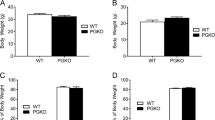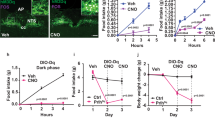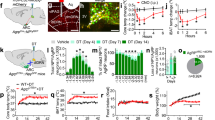Abstract
Background:
Metabolic function is regulated by the interplay of central and peripheral factors that ultimately regulate food intake (FI) and energy expenditure. The tachykinin substance P (SP) has been identified as a novel regulator of energy balance, however, the mechanisms underlying this effect are ill-defined and conflicting data regarding the role of SP on FI have been reported by different groups.
Objective:
To further characterize the metabolic role of the Tac1 gene products (SP and neurokinin A) in mice through a series of genetic, metabolic and behavioral studies in Tac1-deficient mice.
Results:
Tac1−/− mice are leaner than controls and display reduced FI and altered feeding circadian rhythm, supported by disrupted expression of the clock genes Cry1/2, Per1/2 in the suprachiasmatic nucleus, mediobasal hypothalamus (MBH) and liver, as well as increased proopiomelanocortin expression in the MBH. Tac1 ablation induced resistance to obesity, improved glucose tolerance, prevented insulin resistance under high-fat diet, increased activation of brown adipose tissue and improved hepatic steatosis. Moreover, deletion of Tac1 in ob/ob mice ameliorated body weight gain in females only but was sufficient to decrease fat and triglyceride content in the liver of males.
Conclusions:
These results provide further evidence that Tac1 controls circadian feeding behavior and metabolism in mice through mechanisms that involve the regulation of the melanocortin system. In addition, these studies suggest that the blockade of SP may offer a new method to treat metabolic syndrome.
This is a preview of subscription content, access via your institution
Access options
Subscribe to this journal
Receive 12 print issues and online access
$259.00 per year
only $21.58 per issue
Buy this article
- Purchase on Springer Link
- Instant access to full article PDF
Prices may be subject to local taxes which are calculated during checkout




Similar content being viewed by others
References
Onaga T . Tachykinin: recent developments and novel roles in health and disease. Biomol Concepts 2014; 5: 225–243.
Navarro VM, Bosch MA, Leon S, Simavli S, True C, Pinilla L et al. The integrated hypothalamic tachykinin-kisspeptin system as a central coordinator for reproduction. Endocrinology 2015; 156: 627–637.
Ruiz-Pino F, Garcia-Galiano D, Manfredi-Lozano M, Leon S, Sanchez-Garrido MA, Roa J et al. Effects and interactions of tachykinins and dynorphin on FSH and LH secretion in developing and adult rats. Endocrinology 2015; 156: 576–588.
Simavli S, Thompson IR, Maguire CA, Gill JC, Carroll RS, Wolfe A et al. Substance p regulates puberty onset and fertility in the female mouse. Endocrinology 2015; 156: 2313–2322.
Navarro VM . New insights into the control of pulsatile GnRH release: the role of Kiss1/neurokinin B neurons. Front Endocrinol 2012; 3: 48.
Ruiz-Pino F, Navarro VM, Bentsen AH, Garcia-Galiano D, Sanchez-Garrido MA, Ciofi P et al. Neurokinin B and the control of the gonadotropic axis in the rat: developmental changes, sexual dimorphism, and regulation by gonadal steroids. Endocrinology 2012; 153: 4818–4829.
Goodman RL, Coolen LM, Lehman MN . A role for neurokinin B in pulsatile GnRH secretion in the ewe. Neuroendocrinology 2014; 99: 18–32.
Navarro VM, Kaiser UB . Metabolic influences on neuroendocrine regulation of reproduction. Curr Opin Endocrinol Diabetes Obes 2013; 20: 335–341.
Karagiannides I, Torres D, Tseng YH, Bowe C, Carvalho E, Espinoza D et al. Substance P as a novel anti-obesity target. Gastroenterology 2008; 134: 747–755.
Trivedi C, Shan X, Tung YC, Kabra D, Holland J, Amburgy S et al. Tachykinin-1 in the central nervous system regulates adiposity in rodents. Endocrinology 2015; 156: 1714–1723.
Karagiannides I, Bakirtzi K, Kokkotou E, Stavrakis D, Margolis KG, Thomou T et al. Role of substance P in the regulation of glucose metabolism via insulin signaling-associated pathways. Endocrinology 2011; 152: 4571–4580.
Mehlem A, Hagberg CE, Muhl L, Eriksson U, Falkevall A . Imaging of neutral lipids by oil red O for analyzing the metabolic status in health and disease. Nat Protoc 2013; 8: 1149–1154.
Ferrannini E, Natali A, Bell P, Cavallo-Perin P, Lalic N, Mingrone G . Insulin resistance and hypersecretion in obesity. European Group for the Study of Insulin Resistance (EGIR). J Clin Invest 1997; 100: 1166–1173.
Karagiannides I, Stavrakis D, Bakirtzi K, Kokkotou E, Pirtskhalava T, Nayeb-Hashemi H et al. Substance P (SP)-neurokinin-1 receptor (NK-1R) alters adipose tissue responses to high-fat diet and insulin action. Endocrinology 2011; 152: 2197–2205.
Bechtold DA, Loudon AS . Hypothalamic clocks and rhythms in feeding behaviour. Trends Neurosci 2013; 36: 74–82.
Morse D, Sassone-Corsi P . Time after time: inputs to and outputs from the mammalian circadian oscillators. Trends Neurosci 2002; 25: 632–637.
Waterson MJ, Horvath TL . Neuronal regulation of energy homeostasis: beyond the hypothalamus and feeding. Cell Metab 2015; 22: 962–970.
Argyropoulos G, Harper ME . Uncoupling proteins and thermoregulation. J Appl Physiol (1985) 2002; 92: 2187–2198.
Baroncelli GI, Bertelloni S, Buggiani B, Papini A, Gualtieri M, Saggese G . Evidence of increased levels of substance P in obese children. Funct Neurol 1989; 4: 183–184.
Fu J, Liu B, Liu P, Liu L, Li G, Wu B et al. Substance P is associated with the development of obesity, chronic inflammation and type 2 diabetes mellitus. Exp Clin Endocrinol Diabetes 2011; 119: 177–181.
Mittelman-Smith MA, Williams H, Krajewski-Hall SJ, Lai J, Ciofi P, McMullen NT et al. Arcuate kisspeptin/neurokinin B/dynorphin (KNDy) neurons mediate the estrogen suppression of gonadotropin secretion and body weight. Endocrinology 2012; 153: 2800–2812.
Maguire CA, Song YB, Wu M, Leon S, Carroll RS, Alreja M et al. Tac1 signaling is required for sexual maturation and responsiveness of GnRH neurons to Kisspeptin in the male mouse. Endocrinology 2017 158: 2316–2329.
Eckel-Mahan K, Sassone-Corsi P . Metabolism and the circadian clock converge. Physiol Rev 2013; 93: 107–135.
Hatori M, Vollmers C, Zarrinpar A, DiTacchio L, Bushong EA, Gill S et al. Time-restricted feeding without reducing caloric intake prevents metabolic diseases in mice fed a high-fat diet. Cell Metab 2012; 15: 848–860.
Abe H, Honma S, Shinohara K, Honma K . Substance P receptor regulates the photic induction of Fos-like protein in the suprachiasmatic nucleus of Syrian hamsters. Brain Res 1996; 708: 135–142.
Gannon RL, Millan MJ . The selective tachykinin neurokinin 1 (NK1) receptor antagonist, GR 205,171, stereospecifically inhibits light-induced phase advances of hamster circadian activity rhythms. Eur J Pharmacol 2005; 527: 86–93.
Kim DY, Kang HC, Shin HC, Lee KJ, Yoon YW, Han HC et al. Substance p plays a critical role in photic resetting of the circadian pacemaker in the rat hypothalamus. J Neurosci 2001; 21: 4026–4031.
Kim YI, Kim SH, Kim DY, Lee HW, Shin HC, Chung JM et al. Electrophysiological evidence for the role of substance P in retinohypothalamic transmission in the rat. Neurosci Lett 1999; 274: 99–102.
Mick G, Shigemoto R, Kitahama K . Localization of substance P receptors in central neural structures controlling daily rhythms in nocturnal rodents. C R Acad Sci III 1995; 318: 209–217.
Takatsuji K, Oyamada H, Tohyama M . Postnatal development of the substance P-, neuropeptide Y- and serotonin-containing fibers in the rat suprachiasmatic nucleus in relation to development of the retino-hypothalamic projection. Brain Res Dev Brain Res 1995; 84: 261–270.
Kohsaka A, Laposky AD, Ramsey KM, Estrada C, Joshu C, Kobayashi Y et al. High-fat diet disrupts behavioral and molecular circadian rhythms in mice. Cell Metab 2007; 6: 414–421.
Griebel G, Ravinet-Trillou C, Beeske S, Avenet P, Pichat P . Mice deficient in cryptochrome 1 (cry1 (−/−) exhibit resistance to obesity induced by a high-fat diet. Front Endocrinol (Lausanne) 2014; 5: 49.
Vollmers C, Gill S, DiTacchio L, Pulivarthy SR, Le HD, Panda S . Time of feeding and the intrinsic circadian clock drive rhythms in hepatic gene expression. Proc Natl Acad Sci USA 2009; 106: 21453–21458.
Campbell JN, Macosko EZ, Fenselau H, Pers TH, Lyubetskaya A, Tenen D et al. A molecular census of arcuate hypothalamus and median eminence cell types. Nat Neurosci 2017; 20: 484–496.
Scarpace PJ, Matheny M, Pollock BH, Tumer N . Leptin increases uncoupling protein expression and energy expenditure. Am J Physiol 1997; 273 (1 Pt 1): E226–E230.
Martinez de Morentin PB, Gonzalez-Garcia I, Martins L, Lage R, Fernandez-Mallo D, Martinez-Sanchez N et al. Estradiol regulates brown adipose tissue thermogenesis via hypothalamic AMPK. Cell Metab 2014; 20: 41–53.
Dubon MJ, Byeon Y, Park KS . Substance P enhances the activation of AMPK and cellular lipid accumulation in 3T3L1 cells in response to high levels of glucose. Mol Med Rep 2015; 12: 8048–8054.
Allison MB, Patterson CM, Krashes MJ, Lowell BB, Myers MG Jr, Olson DP . TRAP-seq defines markers for novel populations of hypothalamic and brainstem LepRb neurons. Mol Metab 2015; 4: 299–309.
Gargiulo S, Gramanzini M, Megna R, Greco A, Albanese S, Manfredi C et al. Evaluation of growth patterns and body composition in C57Bl/6J mice using dual energy X-ray absorptiometry. Biomed Res Int 2014; 2014: 253067.
Acknowledgements
We thank Dr Alex Banks and Katherine Leclair for their help with the Comprehensive Lab Animal Monitoring System studies. This work was supported by the Eunice Kennedy Shriver National Institute of Child Health and Human Development through cooperative agreement U54 HD028138, R01 HD019938 and R01 HD082314 to UBK; R00 HD071970, Charles H. Hood Foundation for Child Health Research Program to VMN.
Author information
Authors and Affiliations
Corresponding author
Ethics declarations
Competing interests
The authors declare no conflict of interest.
Additional information
Supplementary Information accompanies this paper on International Journal of Obesity website
Supplementary information
Rights and permissions
About this article
Cite this article
Maguire, C., León, S., Carroll, R. et al. Altered circadian feeding behavior and improvement of metabolic syndrome in obese Tac1-deficient mice. Int J Obes 41, 1798–1804 (2017). https://doi.org/10.1038/ijo.2017.185
Received:
Revised:
Accepted:
Published:
Issue Date:
DOI: https://doi.org/10.1038/ijo.2017.185



